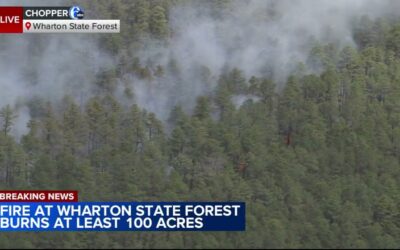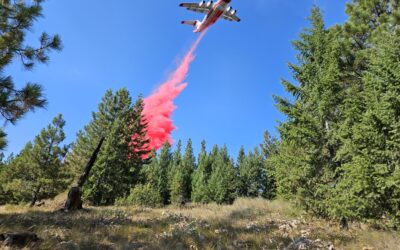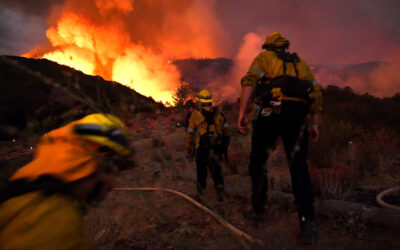The three Republican congressmen sit on the House Agriculture Committee and traveled to South Dakota in a show of support for the timber industry.
Among the dozens in attendance were South Dakota lawmakers, officials in related natural resources professions and timber industry representatives. The panel included Frank Beum, USFS Regional Forester, Rocky Mountain Region; Shawn Cochran, Forest Supervisor, Black Hills National Forest; Marcus Warnke, South Dakota State Forester; and Ben Wudtke, Director, Black Hills Forest Resource Association.
Paul Pierson, Operations Manager for Neiman Enterprises, and Robert Christian, former President of the Black Hills Log Haulers Association, represented the local industry in the discussion.
While each side appeared to recognize the validity of the other’s struggles, consensus on a way forward was not a part of the discussion.
By the numbers
The first-ever federal timber sale occurred in the then-Black Hills Forest Reserve in 1899.
In the 125 years since, the U.S. Forest Service and its private industry partners have worked together to manage the 1.2-million-acres of primarily Ponderosa pine forest.
The agency’s goal, according to Beum, is to manage the forest across multiple uses for both short- and long-term sustainability, manage overall forest health and reduce wildfire risk.
Achieving that goal requires cooperation not only with the forest products industry, but with other regional offices, higher-ups in Washington, contracted partners, local and state government officials and the public. The multi-use, multi-purpose nature of the USFS, Beum explained, makes the agency unique in its operation.
Much of the discussion at the March 2 roundtable revolved around hard data — volume sold, volume cut, allowable sale quantities and contract volume — data that is sometimes disputed, Beum said, and even confused or conflated.
The allowable sale quantity is set by the Forest Plan and is the amount of timber that can be harvested: 202,000 ccf (1 ccf is equal to 100 cubic feet of wood). The Black Hills National Forest Plan was last revised in 1997 and is currently undergoing another revision.
Beum clarified the ASQ is neither a goal nor a target. It’s simply a 10-year average of what the USFS thinks can be harvested based on growth and yield projections — projections impacted by disasters like insect epidemics and wildfires.
From 1996 to 2016, the Mountain Pine Beetle wreaked havoc on the Black Hills National Forest, affecting nearly 450,000 acres. The first recorded outbreak was in the 1890s, killing an estimated 10 million trees. The South Dakota Department of Agriculture and Natural Resources said five outbreaks have occurred since, although none as devastating. An early 1970s outbreak resulted in the loss of more than 440,000 trees.
The Black Hills National Forest averages 100 wildfires each year, 75% of which are caused by lightning strikes, according to the USFS. Some of the largest wildfires in recent years include the Jasper Fire of 2000, which burned more than 80,000 acres near Custer; the Oil Creek Fire that burned 63,000 acres just west of the Black Hills in Wyoming; and the 54,000-acre Legion Lake Fire in 2017.
The ASQ set in 1997 came at a time when the standing volume on the forest was estimated at 13 million ccf. Data published by the USFS in 2020 showed the standing volume at 5.9 million ccf — less than half what it was 27 years ago.
In 2022, they estimated a harvest of 124,000 ccf; 91,000 ccf in 2023 and 88,600 ccf in 2024. The actual totals were 112,000 ccf and 98,000 ccf, respectively. Beum said the agency is confident they can reach 63,000 ccf this year without additional funding.
During the roundtable, Rep. Scott repeatedly inquired how much of the 63,000 ccf has been cut so far. The USFS didn’t have an exact answer, but recent estimates put it in the range of 2,500 ccf, or about 4% of that goal, officials said.
Beum and Cochran also explained there are thousands of acres of timber waiting to be cut, hauled and processed.
Currently, 192,000 ccf of sold timber is sitting uncut on the Black Hills National Forest, Beum said. Specific requirements vary from contract to contract, but timber sale purchasers generally have between one and 10 years to harvest.
The stock price of lumber has fluctuated significantly the past year alone, something Beum said could be the reason why so much timber remains uncut. NASDAQ’s historical data shows lumber futures have spiked sharply this March, and Global Wood Markets Info predicts a positive momentum for the industry in 2024, partially attributable to the upswing in the U.S. housing market.
Ripple effects
Ben Wudtke, director of the Black Hills Forest Association, explained because of land ownership distribution in the Black Hills, forest products companies rely on Forest Service timber sales for more than 75% of their raw material needs.
“As a result of the falling timber sale volumes from the Black Hills National Forest, we’re losing the forest products industry that has made [post-pine beetle and wildfire] success stories possible,” Wudtke said.
Two mills in western South Dakota have closed since the most-recent Mountain Pine Beetle epidemic ended in 2016 — Hills Materials in Spearfish and Rushmore Forest Products in Hill City.
Neiman Enterprises, who operated Rushmore Forest Products, specifically cited the reduction in timber sales as a direct reason for the closure, which eliminated 120 jobs and 12 contract crews. Owner Jim Neiman said at the time the mill, which had been in operation for more than five decades and produced 60 million board-feet per year, relied on the USFS timber sales for 80% of its raw materials.
“If you drive by those sites today, you don’t see a sawmill waiting to be fired back up,” Paul Pierson, operations manager for Neiman Enterprises, said during the roundtable. “When the sawmills close, they’re gone. They’re gone. The skilled labor is gone. They don’t come back.”
According to a 2020 fact sheet from the Forest Service, timber harvests on national forests in South Dakota support approximately $58.5 million in labor income and add $69.2 million to the gross domestic product.
Further down the chain are log haulers, like Robert Christian, who has spent nearly three decades driving a logging truck in the Black Hills. Christian told officials during the discussion the ripple effect of declining timber sales has resulted in a 15% average loss of revenue for him alone each year since 2019.
In another attempt to revitalize the local timber industry, South Dakota Sen. Mike Rounds introduced the Timber Harvesting Restoration Act aimed at improving timber sale numbers on the Black Hills National Forest.
The legislation would require forest supervisors to submit harvesting improvement reports, identify actionable steps — such as expediting environmental review processes — and do so within six months.
Rounds’ bill was introduced at the end of February and referred to the Senate Committee on Agriculture, Nutrition and Forestry.
Red tape
Beum agreed they can’t manage the forest without industry partners, but lamented challenges he and Cochran said handicap the process.
Funding remains a constant stumbling block despite a several-billion-dollar infusion into the Forest Service from the American Rescue Plan Act and Inflation Reduction Act. Beum said during Saturday’s roundtable the agency has “more money than we’ve ever had” because of it.
That statement drew sharp criticism from Scott, who criticized the Biden Administration and congressional Democrats for passing those bills “without a single Republican vote” that resulted in money “not being put where the private citizens need it to be put.”
Beum clarified his remark to the Journal, saying the money was an infusion of short-term funds intended for use honing a 10-year Wildfire Crisis Strategy.
The Senate passed a $460 billion dollar “minibus” just hours before the government shutdown deadline March 8, funding agencies like the Department of Veterans Affairs, Interior, Transportation, Justice and Agriculture. How the funding allocated to the USDA — under which the Forest Service operates — compares to what was expected is unclear, a Black Hills National Forest official told the Journal.
Forest Service Chief Randy Moore said in a release Feb. 8 “all signs point to lower appropriated funds.”
Operating under a continuing resolution instead of a regular appropriations bill — as they have for varying lengths of time off-and-on over the past few years — brings with it its own set of challenges, Beum said.
“That limits our spending authority and influences our ability to enter into agreements, contracts and other financial commitments,” he said. “So, that’s been a challenge for us to try and understand how we fund all of our programs under this (continuing resolution].”
What the Forest Service has done with the available funding, Beum explained, is commit more than $10 million in investments to the Black Hills National Forest.
The last intensified Forest Inventory Analysis done between 2017 and 2019 drew debate and discussion among stakeholders about how the research community interpreted the data, he said, leading the USFS to make other attempts at identifying what is really out there on the forest. In the years since, they’ve put $2 million into lidar for an aerial survey of the land.
That investment is part of nearly $70 million the agency has allocated to the timber program on the Black Hills National Forest over the past three years, Beum said, representing between 20% and 34% of the regional budget for vegetation management.
A 10-person regional strike team was reassigned to the Black Hills from their work on wildfires in Colorado. The USFS has also initiated a timber transit pilot program to bring wood from harvest areas with excess supply to areas with mill infrastructure in need of material. More than 200 rail cars have moved nearly four million board-feet of wood as part of that program. A USDA loan program is also in the works to assist mills in retrofitting their operations to handle different sizes of material.
The biggest sticking point during the March 2 roundtable was Beum’s assertion the agency needs an additional $20 million to reach 120,000 ccf in 2024.
Shawn Cochran, the Black Hills National Forest Supervisor, explained the excess cost is the result of steep-slope logging necessitated by a change in concentration and location of large-diameter trees following the last Mountain Pine Beetle epidemic. Those stands are not only difficult to log — requiring specialized equipment — but are dangerously conducive to the growth of Mountain Pine Beetle populations.
The cost of specialized logging equipment adds an additional per-acre cost of about $4,500, something Cochran said they work on absorbing through outside contracts to avoid placing the burden on the purchaser.
“It’s a very complex issue, predominately tied to meeting forest health concerns,” he said. “The agency is really working to make sure that we have a fine balance of not putting that additional cost on the local purchasers.”
Johnson pressed the Forest Service on the $20 million dollar comment, even asking if it was the only impediment to reaching that number — it isn’t.
The Black Hills National Forest has 76 open positions, a quarter of which are directly tied to forest management. An unusually long hiring process with slow onboarding — on average six months, Cochran guessed — further burdens the Forest Service.
Beum said regionally hiring has been more constrained in the past couple years, but success varies by location. The available labor pool is one impact, but so are factors outside the agency’s control — like the cost of living and remoteness of certain postings.
Cochran said it isn’t just a USFS problem either, but a lack of skilled labor across the board impacting mill owners as well.
The Forest Service’s unique position poses another challenge as well — public intervention.
Extended comment periods on timber sales afford the public an opportunity to weigh-in on how their public lands are utilized. Cochran explained they want to thoroughly examine those comments when reaching decisions, combining public opinion with the extensive environmental regulation process into a lengthy planning period that can take a year or more.
Sometimes those public objections lead to litigation. The most recent either Cochran or Beum could recall was late 1990s or early 2000s and surrounded the management of habitat for a certain species.
Only once they make it through the environmental regulation, public comment and final planning process can a sale occur. It varies from forest to forest, but a percentage of timber sales must first be offered to small businesses (defined as having 500 or fewer employees) through the Small Business Administration. For the Black Hills, that’s at least 75% of all sales.
Going forward
The Forest Service continues to prepare the newest set of data they’ve collected to share with the public. Those numbers, Beum said, should be available sometime this spring.
“We know that our long-term sustainability requires a viable timber industry, and we’re fully committed to that,” Beum said. “We’re just trying to figure out what that looks like in the short- and long-term.”
During the roundtable, Rep. LaMalfa reiterated the need for improvements immediately, not in months or years, saying, “they’re teetering right now … we don’t have months and months.”
“If we don’t find a solution this fiscal year, you’re going to see multiple reductions of forest products industries in the Black Hills National Forest this year,” Neiman operations manager Paul Pierson said. “It’s a given.”
Darsha Dodge is the News Editor of the Rapid City Journal. Contact Darsha at [email protected].
___
(c)2024 Rapid City Journal, S.D.
Visit Rapid City Journal, S.D. at http://www.rapidcityjournal.com
Distributed by Tribune Content Agency, LLC.




